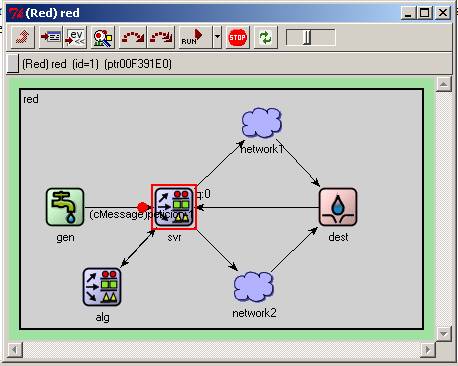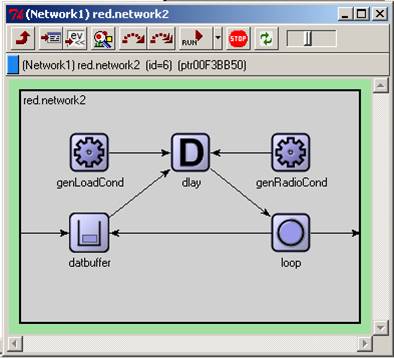The simulation model

A possible simulation model is shown in the first figure, where we can
identify the following Omnet modules:
- gen: the generator module. It creates data packets at certain time
interval. In this case the data packets can be considered to be IP
packets, or they can be considered to be files, of a certain length. This
depends also on the type of traffic that is modelled. For example, if we
model an FTP session, it would be better to consider that the generator
creates files.
- svr: the server. It is actually only a storage element, not a server.
It stores the data packets created by the generator module. The packets
can be stored in one queue, or in several queues, each queue corresponding
to a traffic or to a QoS class.
- alg: the module that implements the VHO algorithm, i.e., the algorithm
that decides on which of the available networks to send the next data
packet.
- dest: the destination module. It is a sink type module, that only
collects statistics and deletes the OMNeT++ messages that model the data
packets. This module informs the server when a data packet has been
completely sent, so that the server can send the next data packet.
- network1, network2: two different networks. The user can chose one of
them in order to send the next data packet.
A possible general model for a network is shown here:

The module called databuffer stores the data packet received
from
the srv module. Then this data packet is send over the corresponding
network. The modules genLoadCond and genRadioCond model the change of the
load in the cell and respectively the change of the radio conditions.
The effective transfer of a data packet is modeled using the delay element
(dly in the figure) and the loop module. If a part of the data packet
(e.g. an IP packet) is send the length of the data packet will be
decreased by the length of the data packet. When the length is zero, it
means that the data packet (the file) has been completely sent, and the
corresponding Omnet message will be sent to the sink (the destination
module). The delay element models the time necessary to send an IP packet.
This time depends on the network load, the radio conditions and on the
type of the network (i.e. GPRS/EGPRS, UMTS, LTE, etc).
Basic (minimal) requirements
Realize a working model like above with only two networks and a dummy
VHO algorithm (e.g. one network is chosen randomly), or with a simple
algorithm (chose the fastest network, or the cheapest network), and
collect results for the implemented algorithm.
More advanced requirements:
- Implement a VHO algorithm described in the literature. You can use for the
VHO algorithm the Customer Surplus (CS) method proposed by Olga Ormond
in [DCU05]
or
[DCU-PIMRC05] . (username: mcs passwd: mcs05 )
Compare the algorithm from literature with the simple one in terms of
performance.
Performance can be expressed by the average delay, the number of
retransmitted files, the network utilization.


